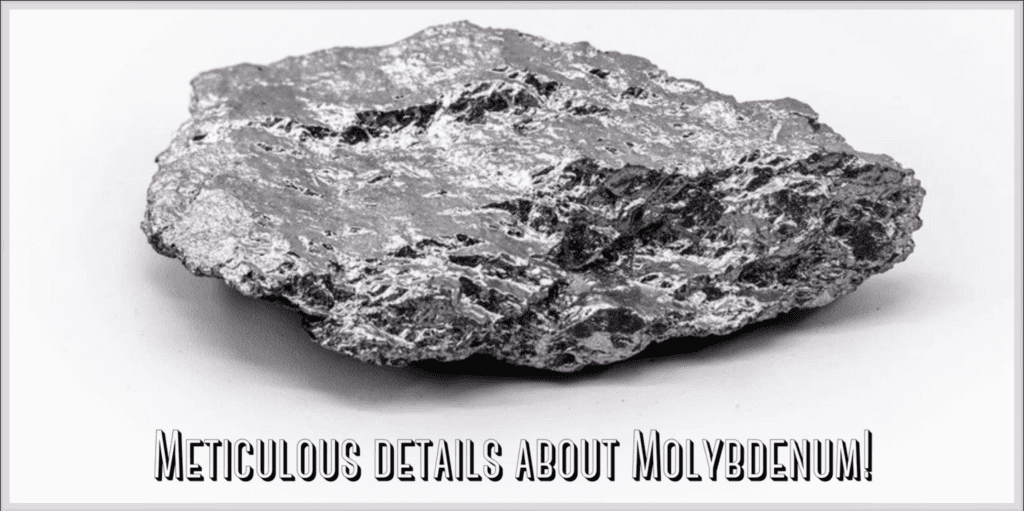Role of molybdenum
The role of molybdenum in the human body is addressed in this article. You may be unfamiliar with the trace mineral molybdenum, but it is critical to your health. Even though your body only needs minimal amounts of it, it is an integral part of many vital functions. Without it, your body would build up dangerous sulfites and toxins. Despite the fact that molybdenum is commonly found in the diet, supplements are commonly used.
Molybdenum, like iron and magnesium, is a mineral without which the body cannot operate. It is found in the soil and enters your body through the consumption of plants and animals that consume those plants.
There is little information on the precise molybdenum level of different foods because it varies on the composition of the soil. Although amounts vary, the richest sources are often beans, lentils, grains, and organ meats, particularly liver and kidney. Fruits, many vegetables, and animal products are poorer suppliers.
According to research, your body does not efficiently absorb it from some foods, particularly soy products. However, this is not considered a problem, given how prevalent it is in other meals.
Molybdenum deficiency is unusual because your body only requires trace amounts of it, which is abundant in many foods. As a result, without special medical requirements, people rarely require supplements.
Cofactor for Vital Enzymes
For several biological activities, the role of molybdenum is critical. After you eat it, it is absorbed into your bloodstream via your stomach and gut, which then carries it to your kidneys, liver, and other organs.
Although most of this mineral is converted into a molybdenum cofactor, some are stored in the liver and kidneys. The excess molybdenum is then excreted in the urine. The molybdenum cofactor activates four crucial enzymes, which are biological components that drive chemical reactions in the body. The four enzymes are as follows:
- Sulfite oxidase: It changes sulfite to sulphate to prevent the body from dangerously accumulating sulfites.
- Aldehyde oxidase: It degrades aldehydes, which can be toxic to the body. It also facilitates the breakdown of several drugs, particularly those used in cancer therapy and alcohol, by the liver.
- Xanthine oxidase: It converts xanthine to uric acid. This mechanism aids in degrading DNA nucleotides when they are no longer necessary. They can then be eliminated through urine.
- Mitochondrial amidoxime reducing component (mARC): Although the precise function of this enzyme is unknown, it is thought to aid in eliminating toxic metabolic wastes.
Molybdenum disorders
The role of Molybdenum includes breaking down sulfites. Sulfites occur naturally in food and are sometimes added as a preservative. If they collect in the body, they may induce an allergic reaction, including skin problems, diarrhoea, or even breathing difficulties.
Despite the widespread availability of molybdenum supplements, molybdenum deficiency is uncommon in otherwise healthy persons. The daily Recommended Dietary Allowance (RDA) for adults is 45 micrograms.
Chronically low levels of molybdenum have been seen in some groups, and oesophageal cancer risk has been raised in association with this impairment. Low molybdenum levels have also been found in hair and nail samples taken from other areas known to have a high prevalence of oesophageal cancer.
In exceedingly rare cases, people have been discovered to be deficient in molybdenum, which has been linked to various serious health concerns. It is significant to bear in mind that nutritional deficiency does not impact the vast majority of individuals and that these isolated events only occur in select communities.
How much do you truly require?
Molybdenum levels in the blood and urine are challenging to assess since they may not necessarily signal the status. As a result, requirements were evaluated using data from a controlled study. The molybdenum RDAs for various populations are listed below.
Children
- 17 mcg daily for children ages 1-3.
- Ages 4 to 8: 22 mcg per day.
- Ages 9 to 13: 34 mcg per day.
- Ages 14 to 18: 43 mcg per day.
Adults
- 45 mcg per day for all persons older than 19 years old.
Women who are expecting or nursing
Molybdenum, a vital mineral, is abundant in organ meats, grains, and legumes. The role of Molybdenum involves activating enzymes that aid in the breakdown of harmful sulfites. Also, Molybdenum prevents toxin buildup in the body.
People rarely take too much or too little of the mineral, yet both have been linked to serious detrimental repercussions. Because molybdenum is included in many common foods, the average daily consumption surpasses the necessary amount. Because of this, most people should avoid using it as a supplement.
If you have a nutritious diet full of wholesome foods, molybdenum is not a mineral to be worried about.


